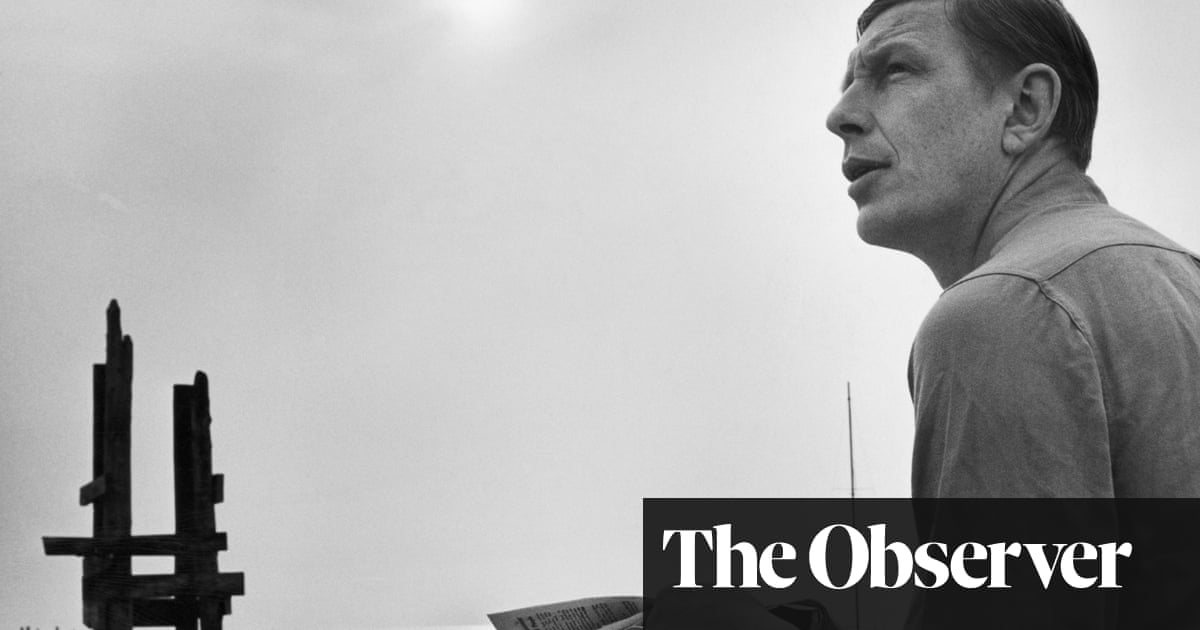Twenty-five years ago, my father and I were out walking in the Peak District. Beside us was his dog; ahead of us was a familiar fell, low and craggy and bare. My dad was boasting, as he often did, about the cairn at its top, a pile of rocks he claimed to have nurtured into existence, when from nowhere the silhouette of a man suddenly appeared beside it: first a head, then a torso, and finally a pair of legs. “Ah,” said my dad, sage where I was startled. “A caver.” We stood and squinted. Moments later, another man materialised, and then another: a human string of sausages, pulled from the limestone’s darkest reaches as if from a top hat.
The memory of this came to me as I read The Island: WH Auden and the Last of Englishness, a new study of the poet and his world. In part, this was because Auden visited the same hills as a schoolboy; even before he famously became transfixed by the abandoned lead mines of the northern Pennines, he had seen – in 1919, when he was 12 – the Blue John Cavern near Castleton in Derbyshire, a place he would later refer to as one of the names on his “numinous map” of sacred spots. Mostly, though, it was because caving is a good metaphor for the experience of reading Nicholas Jenkins’s book, which runs to 543 pages (minus its extensive notes). Headlamp at the ready, I thought, whenever I opened it.
En route, there are lovely moments. After hours (days!) of squeezing yourself through tight passageways – a close reading of a single poem may run to 10 pages – an unexpected vista will at last open out ahead: the kind of view that has you rifling battered paperbacks for more. But such epiphanies are hard won. Jenkins, who teaches at Stanford University, is interested only in the first 30 years of Auden’s life – the book ends in 1937, shortly before the poet’s departure for New York – and even here, he is selective; his focus on notions of Englishness means scant attention is paid to, among other events in this period, Auden’s adventures in the Spanish civil war. In the end, this is not a volume for the general reader, nor even, perhaps, for the Auden fan. If I’m glad to have read it myself, it’s for somewhat mournful reasons. With university Eng lit now in painful decline, such scholarship (and verbosity) feels like a last gasp. In 50 years, or even 10, will people write books like this? It’s hard to believe that they will.
The Island, though highly biographical, is not a biography; the book it most resembles in my eyes is Peter Parker’s Housman Country: Into the Heart of England, a study of AE Housman (though Parker’s instincts – I mean this as a compliment – are more demotic than Jenkins’s). Broadly speaking, it is about the many things that worked on the young Auden, feeding into his poetry; Jenkins, miner-like, digs down into the verse and brings every influence up to the surface (again, I picture a fissure on a hill). The first world war is everywhere, of course: every bit as powerfully black for Auden as “the immense bat-shadow of home”, for all that his generation did not fight.
after newsletter promotion
But there are other mainstays, too: family, school and sex; modernism (Tom Driberg introduced him to TS Eliot at Oxford) and Freud (Auden’s father, the first school medical officer of Birmingham, was an early adopter of psychoanalytic techniques). The result is, at its best, a richly striated landscape, not only in complexity of mood, but also courtesy of its cast of strange, dazzling and sometimes highly dubious characters (though Jenkins is rightly resistant to censoriousness). It’s surprisingly thrilling to imagine Auden listening to JRR Tolkien read aloud from Beowulf (he could understand none of it, but knew in an instant it was “his dish”) – and somewhat grim to read of Geoffrey Hoyland, the headteacher at Downs, a school in the Malverns where Auden was employed in the mid-1930s, wandering a dorm at night, stark naked and fully erect. Some readers will balk at Jenkins’s assertion that Auden was “sincerely in love” with Michael Yates, a 13-year-old pupil.
The raciest chapter is devoted to the period the poet spent in Weimar Berlin, a city where 35,000 male prostitutes were then in business. Auden gets it on with a “beefy sailor” called Gerhart Meyer, though Jenkins is rather more interested in the symbolism of such encounters – these “meetings” with Germans were acts of peacemaking, he instructs, and let us not get too hung up on Auden’s bruises – than in the fun of them; the sheer release. But in truth, I was more drawn to earlier parts of the book, in which we burrow down into Auden’s obsession with the escarpments and industrial archaeology of the north – the landscape he would ultimately hymn in the great poem In Praise of Limestone (1948).
Most of the places Jenkins describes are those that haunt me, too – and though I’ve long known and understood the subterranean links for the poet between the first world war (trenches), mining (shafts and tunnels) and his father (who served in the Royal Army Medical Corps), such connections are brought definitively alive here. It is a little bit wonderful to me that one of Auden’s most treasured manuals in boyhood was called Lead and Zinc Ores of Northumberland and Alston Moor, and next time I’m high on the latter, I might just have my old Selected Poems in my backpack: “This land, cut off, will not communicate…”
